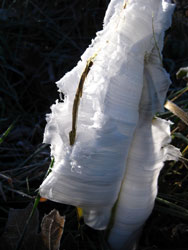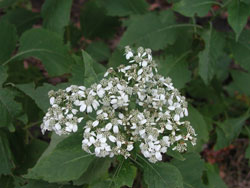Resource Library
Plant of the Week: Rabbit Ice (Frost Flowers, Frost Ribbons, Ice Flowers)
The University of Arkansas System Division of Agriculture does not promote, support or recommend plants featured in "Plant of the Week." Please consult your local Extension office for plants suitable for your region.
Plant of the Week
Frost Flowers

I've often felt sorry for people who sleep in. I know biology makes some of us morning people and some night people, but I'm glad to be a morning person. There seems to be so much more going on at the dawning of a new day than at its close. One of these early morning rarities are the delicate and ephemeral frost flowers seen as the first freezes blanket the landscape.
Frost flowers-also called frost ribbons, ice flowers and rabbit ice-belong to the domain of the early mornings during late fall and early winter. These flowers are fanciful ribbons of delicate white ice crystals that grow from the base of plants on cold nights when the sky is clear and the air cold. Oftentimes these ribbons of ice occupy the basal 6 to 8 inches of the stem but occasionally they will form 18 to 24 inches up the stem.
Usually frost flowers are most abundant in low-lying sunny areas along streams or roadside ditches. Abundant soil moisture seems to be necessary for their formation. These ephemeral beauties vanish with the first warming rays of the sun. If conditions are right the flowers may reappear on the same plant stems on other days, but the display gets shorter and closer to the ground as the number of freezing cycles increases.
Exploring the Web, I found a thoroughly researched report by Dr. James Carter, an emeritus professor from Illinois State University who has done an extensive literature search on the ice flower phenomenon and reports on some of his experiments to grow his own ice ribbons using steel pipes.
Three plants of the daisy family-White Crownbeard or Frostweed (Verbesina virginica), Yellow Ironweed (V. alternifolia) and Frostweed (Helianthus canadense)-seem to be most commonly associated with ice flower formation, though it probably can occur on other plants. In fact, a related phenomenon called silk ice is sometimes seen growing from detached twigs lying on the forest floor.

Using time-lapse photography, Forrest Mims III from Texas shows that these ribbons of ice grow outwards from the split stem of the Verbesina he is photographing. The ice is added to from the base of the ribbon, not crystallized near the terminus of the formation. In Dr. Carter's experiments with pipes that have had their ends smashed flat, we see coiled ribbons of ice that grow from the ends of the pipe as the ice freezes and expands. Plastic pipes Carter used in the beginning weren't tough enough to stand up to the pressure of expanding ice, and split.
Putting these observations together, it seems to me that the xylem (water-conducting) cells near the base of the plants that produce ice flowers must be tough enough to withstand freezing just enough to keep water flowing upward in the stem until such time as the tube ruptures and ice exudes out. As the xylem tube is much smaller than the smashed end of a steel pipe, the resultant ribbon of ice will be correspondingly more delicate.
While this explanation may suffice for the situation shown in the accompanying photo, it doesn't cover all cases. My first experience with frost flowers was the most beautiful and most delicate. Instead of a flower, it was a hollow frost chimney. I spotted these crystalline chimneys in the spring after the roadside weeds had mostly decayed away during the winter, leaving a circular void between the soil and the pith of the plant that grew there. In this case the soil was warmer than the air temperature and steam rose from the ground through these small circular vents. As the steam rose, it crystallized into delicate, inch-wide tubes about a foot tall.
By: Gerald Klingaman, retired
Extension Horticulturist - Ornamentals
Extension News - December 11, 2009
The University of Arkansas System Division of Agriculture does not maintain lists of retail outlets where these plants can be purchased. Please check your local nursery or other retail outlets to ask about the availability of these plants for your growing area.